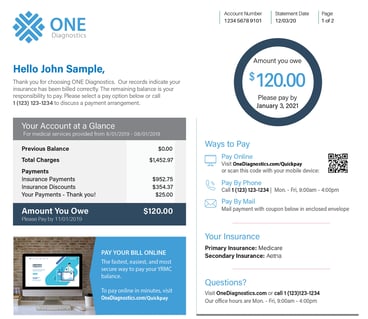Digital Front Door: Paving the Way for Engagement That Drives Payment
May 24, 2021 •Brian Watson

 Digital engagement in healthcare is by no means a new topic. From online scheduling to satisfaction surveys, providers have employed digital channels to help streamline and simplify core engagement tasks for years.
Digital engagement in healthcare is by no means a new topic. From online scheduling to satisfaction surveys, providers have employed digital channels to help streamline and simplify core engagement tasks for years.
Adoption is different than deployment, of course. And usage rates for digital healthcare tools are often uneven at best – with many failing to launch with patients.
So, while patient portal deployment by providers topped 90% in recent surveys from both the Medical Group Management Association (MGMA) and the American Hospital Association (AHA), portal usage rates still fail to crack 30% according to the Government Accountability Office. Similarly, despite a heavy emphasis on paperless billing in recent years, just 29% of patients identified an electronic channel as the primary way they received medical bills.
Healthcare Consumerism, COVID, and the Evolution of Digital Engagement
There’s little question that digital patient engagement is evolving into a critical component of the healthcare revenue cycle. Especially in a post-pandemic marketplace where virtual visits – which skyrocketed to 13% of all insurance claims during COVID-19 – continue to make up more than 5% of total healthcare encounters. Consider the following tailwinds.
Patient financial responsibility continues to grow – and patients are increasingly settling in as experienced healthcare consumers. Eighty-three percent of Americans with employer-provided insurance are now covered by a health plan with a general annual deductible. And the average annual deductible has grown exponentially in the last decade – up a staggering 79% since 2010.
Empowered with more freedom and a stronger, deductible-driven incentive to shop around for care, patients increasingly expect a service experience that puts them front and center. Accustomed to the tools offered by leading consumer brands like Amazon, Apple, and Netflix, patients know what’s out there and want their relationship with a medical provider to be similarly targeted, convenient, and simple.
From the provider side, with out-of-pocket patient financial responsibility approaching historical levels, it’s critical that engagement strategies preserve margins and minimize the financial pressure from self-pay patients. That means doing more with less – including leveraging innovation to amplify rev cycle efficiency.
Maximizing Opt-In with a Digital Front Door Strategy
When it comes to digital engagement, most providers are good at identifying patient demands and responding with new technology. But struggle to present a unified strategy to patients that moves the needle on adoption and engagement metrics.
That’s where a Digital Front Door strategy can help.
Working in tandem with patients to achieve the best possible care outcomes means meeting them where they live. And today that increasingly means online – whether from a laptop, tablet, or phone.
But too often the technologies that support engagement are siloed in a way that prevents full patient buy-in. A patient that opts-in to receive scheduling reminders or wayfinding texts probably isn’t also auto-enrolled in financial alerts or pay-by-text notifications. That’s a missed opportunity to expand the scope of digital engagement. As a result, the patient experience ends up less streamlined and efficient than it could be – for patient and provider.
At its core, Digital Front Door is a wraparound engagement approach that integrates patient-friendly online tech before, during, and post-encounter to streamline and improve the care experience for all. Digital buy-in can come at any step of the process. By integrating online tools at every major touchpoint of the patient journey, it’s easier for providers to build on the tools that patients have already adopted for everyday use.
Digital Front Door isn’t the piecemeal rollout of a single tool. It’s not just about scheduling, or billing, or surveying. It’s a deliberate, cohesive online approach to patient access and communication that extends care outside the practice, making the entire patient experience easier and more convenient.
The Foundation: Preparing Your Practice for Digital
Digitizing patient engagement is a strategy, not a tactic. Building an efficient, productive patient engagement approach means emphasizing your tools – all your tools – with patients at every point of their journey.
If patients don’t know you offer online cost estimates, it doesn’t matter that it’s easy to use or has all the latest bells-and-whistles. A cutting-edge text-to-pay system is great, but if patients don’t know how to opt-in, it’s not adding efficiency.
Moving from a piecemeal engagement approach to a all-inclusive Digital Front Door approach can be accomplished with a little advanced planning. Here are a few potential starting points:
- Consider your overarching strategic goals before building a practice-level action plan. What are the specific digital engagement adoption targets you hope to meet? Which metrics will be used to assess your progress? What timeline is appropriate to reach your goals? Identifying your goals in advance will make it easier to pinpoint and implement detailed tactics and adjust mid-stream if performance metrics aren’t being met.
- Map out your engagement tools as steps in the process of a patient journey. Completing this process can help you better conceptualize where patients interact with each Digital Front Door during pre-visit, point-of-service, and post-encounter. It’s also useful for understanding potential connections between each standalone tool to identify areas where a patient opting-in to one technology might present a bridge for adoption of additional engagement tools.
- Leverage natural conversion points to move patients from single-use adoption to multi-channel users. Efficiency and satisfaction closely track multi-channel engagement use, so maximizing service adoption is a smart play. Some pivot points are clear: patient portal adoption is generally a good starting point for encouraging use of everything from online scheduling to paperless billing to prescription refills. Others require a little more setup. For example, a patient that opts-in to receive text appointment reminders or wayfinding instructions is also a good candidate for SMS billing updates and, eventually, pay-by-text. In that scenario, multi-tool authentication can help capture permission for both appointment- and financial-based engagement at the same time. Look for similar ways to consolidate adoption when a patient opts-in to use a single engagement tool.
- Build an integrated marketing strategy to communicate the ease and convenience of your menu of options. Ideally, this should be intentional and frequent – at all touchpoints. Whenever a patient is ready for opt-in, they should understand how to make the switch.
- Cultivate an “up-front” mindset. The best time for a patient to open a Digital Front Door is often before or during care. Once a patient has disengaged from their care experience, reintroducing digital touchpoints requires more time, effort, and resources. Make opt-in to digital a priority during intake, care, and any financial discussions. Involve your staff as much as possible – front-office, back-office, and providers – to communicate the benefits of digital tools and assist patients with sign-up and opt-in.
Gaining Consent: Optimized for Opt-In
Privacy regulations like the Telephone Consumer Protection Act (TCPA) and CAN-SPAM restrict delivery of messages through outbound IVR, text message, and email. And heavy fines await offenders.
For that reason, it’s important to ensure that you’ve established terms and conditions for opt-in/-out that describe your approach and protect against potential regulatory violations. Patients providing phone/email information must be accompanied by explicit written consent prior to engagement for items identified in a provider’s Notice of Privacy Practices.
Consent may be granted by a patient on a form at intake or during a financial consultation. That said, digital authorization – through an intake platform or completed via a patient portal – tends to be a more efficient way to streamline consent management and enable an easy-to-track audit trail.
Once consent is obtained in writing, dual-authentication should be used to confirm patient consent. Sending an initial email or text “welcome” message that asks the patient to approve their opt-in is considered gold standard policy for confirming engagement authorization. Even though it may seem like overkill to send a text to confirm your ability to send additional texts, that extra layer of protection is crucial to avoid potential fines from unapproved communication.
And remember: patient consent covers the activities of downstream vendors. So, a text delivery solution vendor doesn’t need to receive separate authentication if the patient has already approved text billing reminders at intake or using a portal.
Connecting Online with Offline: Statement Cycle Integration
In a 2020 survey, over two-thirds of patients identified mail delivery as the primary way they received medical bills.
While paperless billing continues to grow incrementally, traditional paper statements have a reach that digital channels can’t match at the moment. And the average consumer spends between 2-3 minutes examining each transactional billing document they receive. The upshot: statement print-and-mail remains the best engagement option your practice has for getting messaging in front of patients.
Leverage that captive audience to use your statements as a conversion tool.
On-statement prompts, messaging, and ads can boost awareness of digital financial tools like online billing and payment, patient portals, and text-to-pay. Use of streamlining technology, like personalized “easy” authorization codes or QR Codes, can help reduce the friction involved with channel sign-up and use – increasing adoption and utilization.

The Wrap-Up
Digital Front Door is a complete transformation from traditional revenue cycle ops. And it can seem overwhelming. But just like anything else, it’s easier when you have clearly defined goals and a plan to work.
Remember: digitizing patient engagement is a strategy, not a tactic. Use your channels to improve relationships. Add meaningful touchpoints that enable faster, more intuitive patient engagement. And make each communication as important, personal, and accurate as possible.
Meeting patients where they will ultimately provide better results – for you and your patients.
Get Updates
Featured Articles
Categories
- Charity Care Management (1)
- Compliance (2)
- Customer Service (8)
- Digital Front Door (1)
- Direct Mail (6)
- eBilling (1)
- EBPP (34)
- ESL Statement (2)
- eStatement (1)
- Healthcare Channel Partner Billing (1)
- IVR (3)
- Mobile Payment (11)
- Online Billing and Payment (6)
- Online Patient Payment (17)
- Outsource Print Management (4)
- Paperless Billing (4)
- Patient Engagement (2)
- Patient Friendly Billing (21)
- Print and Mail (7)
- QR Codes (1)
- Quick Pay (7)
- Security (1)
- Self-Pay Patients (9)
- Self-Pay Revenue (4)
- Statement Design (32)
- Statement Print and Mail (1)
- Statement Printing and Mailing (28)
- Statement Processing (36)
- TransPromo (1)
- Up-Front Billing (1)

